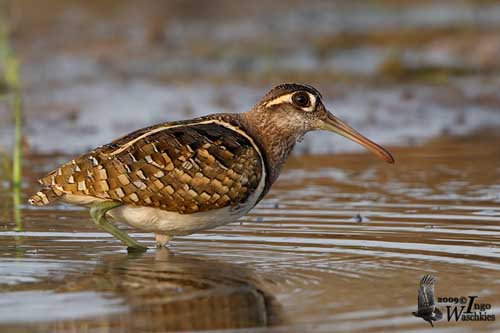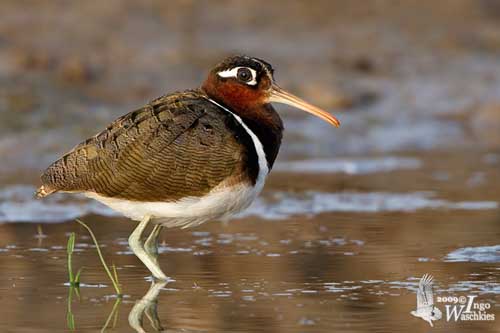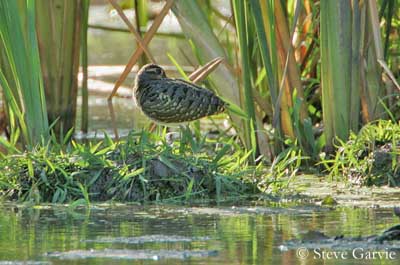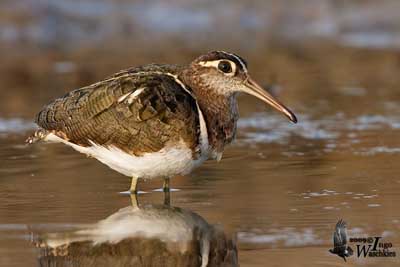
DIET:
The Greater Painted-snipe feeds on invertebrates and seeds. Invertebrates include insects such as grasshoppers and crickets, snails, earthworms and crustaceans. The seeds are those of several grasses, rice and millet.
It forages by probing in shallow water into the soft soil, moving the bill sideways in semi-circular movement.
PROTECTION / THREATS / STATUS:
The Greater Painted-snipe may be locally common, or uncommon to frequent according to the range. Some declines occur due to the drainage of wetlands and destruction of suitable habitat.
This species is evaluated as Least Concern by Birdlife International.
Fr: Rhynchée peinte
All : Goldschnepfe-benghalensis
Sd: Rallbeckasin
Photographers:
Steve Garvie
RAINBIRDER Photo galleries
Ingo Waschkies
My bird pictures on Pbase
Text by Nicole Bouglouan
Sources:
HANDBOOK OF THE BIRDS OF THE WORLD Volume 3 by Josep del Hoyo-Andrew Elliott-Jordi Sargatal - Lynx Edicions - ISBN : 8487334202
L’ENCYCLOPEDIE MONDIALE DES OISEAUX - Dr Christopher M. Perrins - BORDAS - ISBN: 2040185607
GUIDE DES LIMICOLES de D. Taylor - Delachaux et Niestlé - ISBN : 2603014080
BirdLife International (BirdLife International)
Wikipedia, the free encyclopaedia
Greater Painted-snipe
Rostratula benghalensis
Charadriiforme Order – Rostratulidae Family
BIOMETRICS:
Length: 23-28 cm
Wingspan: 50-55 cm
Weight: 90-200 g
DESCRIPTION:
The Greater Painted-snipe is a plump wading bird. The female shows brighter plumage than the male, and their roles are reversed during the breeding season.
Adult male has golden-buff, brown and black upperparts, and mainly on the upperwing-coverts, forming a kind of barring. On the back, we can see a golden V on mantle. The tail is short and shows similar pattern.
The underparts and underwing are white.
Head and neck are greyish-brown with ashy-grey wash on neck. The throat is brown streaked white. Throat and neck sides are edged whitish, forming a separation between them and the white lower underparts.
The crown shows creamy median stripe and we can see a pale golden eye-patch.
The long, slightly down-curved bill is pale yellow at base and pale brown towards the tip. The eyes are dark brown. Legs and feet are greenish-yellow.

Adult female has brighter plumage with similar pattern and longer wings. Upperparts and wings are dark bronze-green, narrowly barred black. We can see the buff-white V on the mantle, as in male.
The underparts are white.
Head and neck are dark rufous, and the white eye-patch contrasts strongly. The crown shows creamy-white stripe too. Bill, eyes, legs and feet are similar to male.

The juvenile resembles male but lacks first the pale stripe between the dark upper breast and the white lower underparts. The wing-coverts are greyer with small, pale buff spots.
The immature male and female resemble adult male.
The subspecies R.b. australis has much longer wings and similar plumage.
VOICE: SOUNDS BY XENO-CANTO
The Greater Painted-snipe is silent outside the breeding season. When disturbed, it occasionally utters an explosive “kek” or a guttural croak. Alarm calls are a variety of deep, almost snake-like sounds.
The female is usually more vocal, giving more resonant calls than male. While displaying, she utters soft, metallic, long hooting calls “koht-koht-koht” in series of up to 80 notes. These calls are given from the ground or as single notes during a low flight at dusk or by night.
The male has few specific sounds, mainly used at nest-site. However, explosive or growling calls are used in nest defence.
A short, sharp squeak call is given as response to the courting female.
HABITAT:
The Greater Painted-snipe frequents tropical and subtropical wetlands, up to 1800 metres of elevation in the Himalayas, and much lower elsewhere. This bird is found in swamps, reedbeds, ricefields, muddy margins of pools, freshwater lakes, mudflats with marsh grass and mangroves.
This species avoids the dry locations and prefers the recently flooded areas.

RANGE:
The Greater Painted-snipe occurs in Africa, Madagascar, India, Pakistan and SE Asia.
The race “australis” is found in the eastern part of Australia.
BEHAVIOUR:
The Greater Painted-snipe is omnivorous, feeding on insects, snails, earthworms and crustaceans. It also takes plant matter such as seeds, rice and millet.
It probes as the other snipes (Gallinago) with the long bill into the soft soil. It also moves head and bill sideways in shallow water with semi-circular movements.
This snipe is mainly crepuscular and may also feed at nigh. It is often seen alone, sometimes in small groups and rarely in large flocks.

The Greater Painted-snipe often has polyandrous mating system, but it also may be monogamous when densities are low. The females can mate with 2, 3 or 4 males every year. The female leaves the male after the laying, to mate with another one while the previous male performs all the nesting duties.
The “spread-wing display” is used in several situations, as well sexual as territorial. This display is mainly performed by females. The male uses it only in defence.
Both wings or only one can be extended according to the situation. The tail is fanned and lowered. In full display, the birds are facing each other with both wings extended and slightly arched forwards. The tail is fanned and raised, and bill and body are lowered towards the male or the intruder.
The females are highly territorial. During the courtship displays, the female preens its future mate before the “spread-wing display”. She circles the male while uttering soft calls. Once the copulation occurred, they stand close to each other and call, while the female sometimes opens and lifts the wings upwards.
The Greater Painted-snipe is sedentary in Asia and Egypt. In the other parts of the range, short distance seasonal movements are observed according to food sources and nesting-sites.
The race “australis” is strongly nomadic in Australia.
The bird remains solitary outside the breeding period, but small to large flocks may gather at abundant food sources and in suitable habitats.

FLIGHT:
The Greater Painted-snipe usually appears weak in flight, but it performs deep wing-beats. The flight is often direct with dangling legs.
But these birds prefer to run for reaching the cover when alarmed.
REPRODUCTION:
The breeding season varies strongly throughout the range, and is closely related to the rainfalls.
The Greater Painted-snipe is solitary nester, but several nests can be seen together due to the polyandrous mating system.
The nest is placed on the ground, concealed in thick vegetation, or sometimes on mound. It can also be built in more open aquatic area, on dense floating vegetation. The nest is a shallow cup made with interwoven plant material, and lined with leaves and stems.
The female lays 2-5 eggs heavily marked dark on pale buff-yellow background. The incubation by the male alone lasts about 18-19 days. It spends most of the time on the nest.
The downy chicks are precocial, only brooded and dependent for few days. The fledging period is unknown. The male care them during some days after they leave the nest.
One female may lay up to 4 clutches per season.
